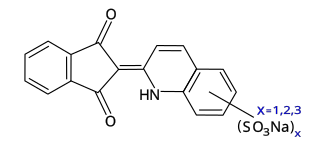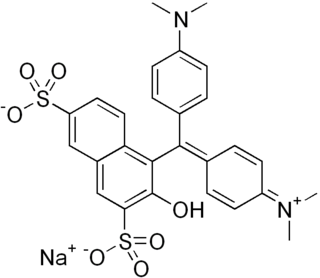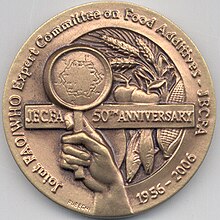
Food additives are substances added to food to preserve flavor or enhance taste, appearance, or other sensory qualities. Some additives have been used for centuries as part of an effort to preserve food, for example vinegar (pickling), salt (salting), smoke (smoking), sugar (crystallization), etc. This allows for longer-lasting foods such as bacon, sweets or wines. With the advent of processed foods in the second half of the twentieth century, many additives have been introduced, of both natural and artificial origin. Food additives also include substances that may be introduced to food indirectly in the manufacturing process, through packaging, or during storage or transport.

E numbers are codes for substances used as food additives, including those found naturally in many foods such as vitamin C, for use within the European Union (EU) and European Free Trade Association (EFTA). Commonly found on food labels, their safety assessment and approval are the responsibility of the European Food Safety Authority (EFSA). The fact that an additive has an E number implies that its use was at one time permitted in products for sale in the European Single Market; some of these additives are no longer allowed today.

Disodium inosinate (E631) is the disodium salt of inosinic acid with the chemical formula C10H11N4Na2O8P. It is used as a food additive and often found in instant noodles, potato chips, and a variety of other snacks. Although it can be obtained from bacterial fermentation of sugars, it is often commercially prepared from animal products.

Quinoline Yellow WS is a mixture of organic compounds derived from the dye Quinoline Yellow SS. Owing to the presence of sulfonate groups, the WS dyes are water-soluble (WS). It is a mixture of disulfonates (principally), monosulfonates and trisulfonates of 2-(2-quinolyl)indan-1,3-dione with a maximum absorption wavelength of 416 nm.p. 119

Sunset yellow FCF is a petroleum-derived orange azo dye with a pH dependent maximum absorption at about 480 nm at pH 1 and 443 nm at pH 13 with a shoulder at 500 nm. When added to foods sold in the United States it is known as FD&C Yellow 6; when sold in Europe, it is denoted by E Number E110.
Acceptable daily intake or ADI is a measure of the amount of a specific substance in food or drinking water that can be ingested (orally) daily over a lifetime without an appreciable health risk. ADIs are expressed usually in milligrams per kilograms of body weight per day.

The Codex Alimentarius is a collection of internationally recognized standards, codes of practice, guidelines, and other recommendations published by the Food and Agriculture Organization of the United Nations relating to food, food production, food labeling, and food safety.

Green S is a green synthetic coal tar triarylmethane dye with the molecular formula C27H25N2O7S2Na.

Caramel color or caramel coloring is a water-soluble food coloring. It is made by heat treatment of carbohydrates (sugars), in general in the presence of acids, alkalis, or salts, in a process called caramelization. It is more fully oxidized than caramel candy, and has an odor of burnt sugar and a somewhat bitter taste. Its color ranges from pale yellow to amber to dark brown.

Food safety is used as a scientific method/discipline describing handling, preparation, and storage of food in ways that prevent food-borne illness. The occurrence of two or more cases of a similar illness resulting from the ingestion of a common food is known as a food-borne disease outbreak. This includes a number of routines that should be followed to avoid potential health hazards. In this way, food safety often overlaps with food defense to prevent harm to consumers. The tracks within this line of thought are safety between industry and the market and then between the market and the consumer. In considering industry to market practices, food safety considerations include the origins of food including the practices relating to food labeling, food hygiene, food additives and pesticide residues, as well as policies on biotechnology and food and guidelines for the management of governmental import and export inspection and certification systems for foods. In considering market to consumer practices, the usual thought is that food ought to be safe in the market and the concern is safe delivery and preparation of the food for the consumer. Food safety, nutrition and food security are closely related. Unhealthy food creates a cycle of disease and malnutrition that affects infants and adults as well.

Disodium 5'-ribonucleotides, E number E635, is a flavor enhancer which is synergistic with glutamates in creating the taste of umami. It is a mixture of disodium inosinate (IMP) and disodium guanylate (GMP) and is often used where a food already contains natural glutamates or added monosodium glutamate (MSG). It is primarily used in flavored noodles, snack foods, chips, crackers, sauces and fast foods. It is produced by combining the sodium salts of the natural compounds guanylic acid (E626) and inosinic acid (E630).

Ractopamine is an animal feed additive used to promote leanness and increase food conversion efficiency in farmed animals in several countries, but banned in others. Pharmacologically, it is a phenol-based TAAR1 agonist and β adrenoreceptor agonist that stimulates β1 and β2 adrenergic receptors. It is most commonly administered to animals for meat production as ractopamine hydrochloride. It is the active ingredient in products marketed in the US as Paylean for swine, Optaflexx for cattle, and Topmax for turkeys. It was developed by Elanco Animal Health, a division of Eli Lilly and Company.
A food safety-risk analysis is essential not only to produce or manufacture high quality goods and products to ensure safety and protect public health, but also to comply with international and national standards and market regulations. With risk analyses food safety systems can be strengthened and food-borne illnesses can be reduced. Food safety risk analyses focus on major safety concerns in manufacturing premises—not every safety issue requires a formal risk analysis. Sometimes, especially for complex or controversial analyses, regular staff is supported by independent consultants.
The Hungarian Food Safety Office (HFSO) operated as the Hungarian partner institution of the European Food Safety Authority (EFSA) from 2003 to 2012 in conformity with the EU requirements. One of its priority was to assess the health risks derived from food and indirectly from feed, to liaise with international and Hungarian authorities, and to communicate with the public on food safety issues. From 2012, these tasks are performed by the National Food Chain Safety Office, which was established by the integration of the Central Agricultural Office and HFSO.
Synthetic magnesium silicates are white, odorless, finely divided powders formed by the precipitation reaction of water-soluble sodium silicate and a water-soluble magnesium salt such as magnesium chloride, magnesium nitrate or magnesium sulfate. The composition of the precipitate depends on the ratio of the components in the reaction medium, the addition of the correcting substances, and the way in which they are precipitated.

Ethane-1,1-dithiol is an organosulfur compound with formula CH3CH(SH)2. It is a colourless smelly liquid that is added to or found in some foods. The compound is an example of a geminal dithiol.

The German Federal Institute for Risk Assessment, abbreviated BfR, is a body under public law of the German federal government with full legal capacity. The institute comes under the portfolio of the Federal Ministry of Food and Agriculture and has the task of providing scientific advice to the federal government on issues relating to food safety, product safety, chemical safety, contaminants in the food chain, animal protection and consumer health protection. Further technical supervision is performed by the Federal Ministry for the Environment, Nature Conservation, Building and Nuclear Safety and the Federal Ministry of Transport.
Tolerable weekly intake (TWI) estimates the amount per unit body weight of a potentially harmful substance or contaminant in food or water that can be ingested over a lifetime without risk of adverse health effects. TWI is generally preceded by "provisional" to indicate insufficient data exists, increasing uncertainty. The term TWI should be reserved for when there is a well-established and internationally accepted tolerance, backed by sound and uncontested data. Although similar in concept to tolerable daily intake (TDI), which is of the same derivation of acceptable daily intakes (ADIs), TWI accounts for contaminants that do not clear the body quickly and may accumulate within the body over a period of time. An example is heavy metals such as arsenic, cadmium, lead, and mercury. The concept of TWI takes into account daily variations in human consumption patterns.
The Food Chemicals Codex (FCC) is a collection of internationally recognized standards for the purity and identity of food ingredients.

N,N-Dimethylphenethylamine (N,N-DMPEA) is a substituted phenethylamine that is used as a flavoring agent. It is an alkaloid that was first isolated from the orchid Eria jarensis. Its aroma is described as "sweet, fishy". It is mainly used in cereal, cheese, dairy products, fish, fruit and meat. It is also being used in pre-workout and bodybuilding supplements with claims of a stimulant effect.













